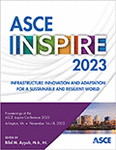Hazard Mapping and Analysis of Wildfires: An Oklahoma Case Study
Publication: ASCE Inspire 2023
ABSTRACT
Wildfires cause severe damage to land and infrastructure resulting in the federal government spending billions of dollars annually. Climate change, along with changes in land cover and socioecological conditions, has intensified the frequency and size of wildfires, primarily due to worsening hot, dry, and windy weather conditions. The ability to model these wildfires analytically will play a crucial role in the development of resiliency strategies through risk and fragility analysis of infrastructure components. Up-to-date wildfire and wildland-urban-interface data for Oklahoma, acquired through the US Department of Agriculture, was analyzed to understand the changing wildfire risk due to the changing climate, fuel sources, and encroachment dynamics. The data was analyzed to determine critical factors for future wildfire modeling efforts. Additionally, wildfire hazard maps for Oklahoma were developed.
Get full access to this article
View all available purchase options and get full access to this chapter.
REFERENCES
Athanasis, N., Themistocleous, M., and Kalabokidis, K. (2017). Wildfire Prevention in the Era of Big Data. In Information Systems, pages 111–118. Springer International Publishing.
Baijnath-Rodino, J. A., Kumar, M., Rivera, M., Tran, K. D., and Banerjee, T. (2021). How Vulnerable are American States to Wildfires? A Livelihood Vulnerability Assessment. Fire, 4(3):54.
Balch, J. K., Bradley, B. A., Abatzoglou, J. T., Nagy, R. C., Fusco, E. J., and Mahood, A. L. (2017). Human-started wildfires expand the fire niche across the United States. Proceedings of the National Academy of Sciences, 114(11):2946–2951.
Barbero, R., Abatzoglou, J. T., Larkin, N. K., Kolden, C. A., and Stocks, B. (2015). Climate change presents increased potential for very large fires in the contiguous United States. International Journal of Wildland Fire, 24(7):892.
Costafreda-Aumedes, S., Comas, C., and Vega-Garcia, C. (2017). Human-caused fire occurrence modeling in perspective: a review. International Journal of Wildland Fire, 26(12):983.
Donovan, V. M., Wonkka, C. L., and Twidwell, D. (2017). Surging wildfire activity in a grassland biome. Geophysical Research Letters, 44(12):5986–5993.
Donovan, V. M., Wonkka, C. L., Wedin, D. A., and Twidwell, D. (2020). Land-Use Type as a Driver of Large Wildfire Occurrence in the U.S. Great Plains. Remote Sensing, 12(11):1869.
Guzzetti, F., Carrara, A., Cardinali, M., and Reichenbach, P. (1999). Landslide hazard evaluation: a review of current techniques and their application in a multi-scale study, Central Italy. Geomorphology, 31(1-4):181–216.
Hoff, D., Will, R., Zou, C., and Lillie, N. (2018). Encroachment Dynamics of Juniperus virginiana L. and Mesic Hardwood Species into Cross Timbers Forests of North-Central Oklahoma, USA. Forests, 9(2):75.
Lindley, T. T., Speheger, D. A., Day, M. A., Murdoch, G. P., Smith, B. R., Nauslar, N. J., and Daily, D. C. (2019). Megafires on the Southern Great Plains. Journal of Operational Meteorology, 7(12):164–179.
NFIC. (2022). Wildland Fire Open Data. Available at https://data-nifc.opendata.arcgis.com/search?tags=Category%2Chistoric_wildlandfire_opendata Accessed 15 October 2022.
Oliveira, S., Rocha, J., and Sá, A. (2021). Wildfire risk modeling. Current Opinion in Environmental Science & Health, 23:100274.
Reid, A. M., Fuhlendorf, S. D., and Weir, J. R. (2010). Weather variables affecting Oklahoma wildfires. Rangeland Ecology & Management, 63(5):599–603.
Sadatrazavi, A., Motlagh, M. S., Noorpoor, A., and Ehsani, A. H. (2022). Predicting Wildfires Occurrences Using Meteorological Parameters. International Journal of Environmental Research, 16(6):106.
Short, K. C. (2022). Spatial wildfire occurrence data for the United States, 1992-2020 [].
Smith, A. B. (2020). U.S. Billion-dollar Weather and Climate Disasters, 1980 - present.
Wylie, B. K., Meyer, D. J., Tieszen, L. L., and Mannel, S. (2002). Satellite mapping of surface biophysical parameters at the biome scale over the North American grasslands. Remote Sensing of Environment, 79(2-3):266–278.
Zhang, Y., Fan, J., Shrivastava, M., Homeyer, C. R., Wang, Y., and Seinfeld, J. H. (2022). Notable impact of wildfires in the western United States on weather hazards in the central United States. Proceedings of the National Academy of Sciences, 119(44):e2207329119.
Information & Authors
Information
Published In
History
Published online: Nov 14, 2023
ASCE Technical Topics:
- Business management
- Case studies
- Data analysis
- Disaster risk management
- Disasters and hazards
- Engineering fundamentals
- Federal government
- Geomatics
- Government
- Infrastructure
- Infrastructure resilience
- Mapping
- Methodology (by type)
- Natural disasters
- Organizations
- Practice and Profession
- Research methods (by type)
- Risk management
- Surveying methods
- Wild fires
Authors
Metrics & Citations
Metrics
Citations
Download citation
If you have the appropriate software installed, you can download article citation data to the citation manager of your choice. Simply select your manager software from the list below and click Download.
